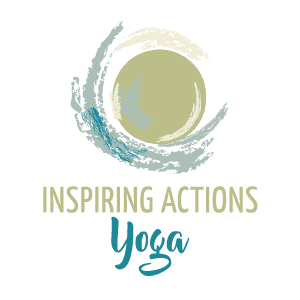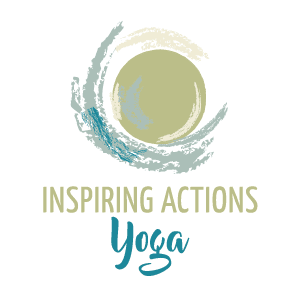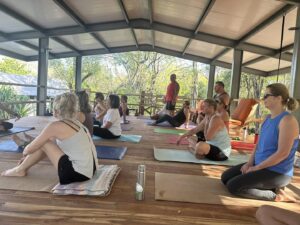When you’re new to yoga, the number of new terms you’re exposed to can be overwhelming. There are names for poses, different styles of yoga, and frequently used Sanskrit references that are like a foreign language to a new yogi. It’s intimidating enough to be unfamiliar with how to perform the poses; the combination of that and not knowing the jargon might keep someone from trying yoga. If that is you, please understand that knowing yoga terms or poses is not necessary to get started in yoga. That’s why they call it a ‘beginner’ class!
If you start a consistent practice, you will pick up common yoga lingo in very little time. However, knowing a pose or two and a few of the commonly used terms can help you be more focused in class and spend less time watching the instructor or getting distracted by the unfamiliar terms. Yoga terms confused me at first (and every other yogi at their beginning!) and although it’s not necessary to know them to take a yoga class, it is definitely helpful! In this post, we’ll define six common yoga terms and how they may come up in a class.
Yoga Term #1 – Yoga
Let’s start with the word ‘yoga’ itself. Yoga in Sanskrit translates to ‘to yoke’ or ‘union’. It refers to the reuniting of mind, body, and spirit that yoga promotes. A common yoga misconception is that yoga refers to the postures that you would see in a typical class. But yoga is actually an umbrella term used to describe the Eight Limb Path of Yoga, the yogic path to enlightenment. What most people think of as ‘yoga’ is actually asana, the physical postures of yoga. Doing yoga’ then, refers to engaging with all the steps, not just the postures, known as asana in Sanskrit.

Yoga Term #2 – Sun Salutations
Surya Namaskar in Sanskrit, Sun Salutations are a sequence of asanas that are typically used at the beginning of a class. There are two different sequences, Sun Salutation A and Sun Salutation B. The poses are about honoring the sun, and in ancient times were used as part of Hindu prayer and worship. Sun Salutations are a good introduction to vinyasa (flow) yoga. They are common in many styles of yoga and are often referred to as Sun A and Sun B in class.
Yoga Term #3 – Chaturanga
Depending on the type of class you might hear ‘chaturanga’; the full term is ‘chaturanga dandasana’ in Sanskrit which translates to ‘four limb staff pose’. It plays an important role in vinyasa (flow) classes that include Sun Salutations. If you hear this yoga term in class, it will typically be part of a standing series. Chaturanga involves plank pose which can be difficult for some, so most instructors will offer a modification for this series.
Yoga Term #4 – Vinyasa
This is the term that confused me the most, and that is because it is used in several different contexts in yoga. Vinyasa refers to the continuous flow of movement from one pose to the next, as well as connection of movement and breath. In a yoga class, this typically refers to inhaling for an open, expanding move and exhaling for a contracted pose. Most yoga instructors will call this breathing pattern out in class. In modern yoga, vinyasa is used to describe classes that incorporate this concept of continuous flow. If a class has the word vinyasa in the description, it will likely be a more physical class that feels like a cardio workout.

Yoga Term #5 – Hatha
Hatha refers to all the asana (physical postures of yoga) and pranayama (breathing techniques). It is a very broad term; if you are doing any type of yoga poses or breathing exercises, that is Hatha yoga. Styles like ashtanga and vinyasa fall under the Hatha umbrella. A class described as hatha might be more beginner level, including mostly commonly known poses, but this is not always the case. Hatha, as a philosophy, uses six tools:
- Asanas – to gain connect with the body
- Pranayama – to use the breath to stimulate prana (life force energy)
- Mudra – to manipulate and stimulate prana
- Bandhas – to stimulate chakras (energy centers)
- Kriyas – to purify internal organs
- Mantras – to control the mind
Yoga Term #6 – Drishti
Drishti is a focal point, an anchor to use during balancing poses in class or in your personal practice. When a ballerina is spinning, they pick a nonmoving point somewhere out in the distance to return their gaze to with each spin, to keep balance. Drishti is used in this context in yoga classes often, encouraging participants to select a drishti during poses that involve balance challenges. We can take the concept of drishti off the mat as well, creating specific focal points or goals in our life and using them as a constant source of balance we can return to.
Looking for more information about yoga? Visit our blog page for tons of articles about all things yoga, including a series about the Eight Limb Path of Yoga and the Seven Chakras. At Inspiring Actions, we promote all aspects of yoga, beyond just the physical postures. We offer classes for beginners all the way to teacher training. Take a look at our full schedule here, as well as our events page for things like sound baths, drum circles, free karma yoga, and more! Our studios are in Hudson and River Falls, Wisconsin, but some of our classes are offered online.
Is there a yoga term you’d like to learn more about, or a different yoga-related topic? Leave a comment below and let us know what you’d like to read about!




